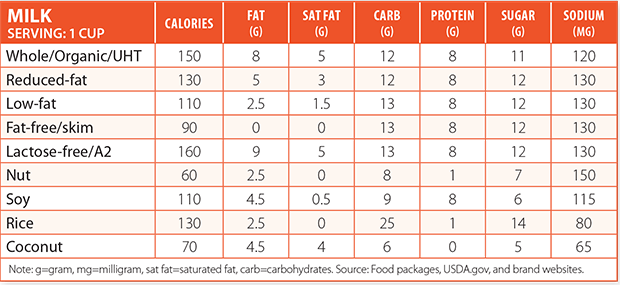Demystifying Today’s Milk Choices
In the U.S., milk is a primary part of most children’s diets from the time they’re born. However, adults often outgrow the taste, or develop an intolerance to the milk-sugar lactose. As a result, more than 80 percent of people in the U.S. don’t meet their daily recommended requirement of 3 cups of low-fat dairy products (milk, yogurt, and cheese) per day, according to the U.S. Department of Agriculture (USDA).
Calcium, a key nutrient in dairy, is critical for preventing bone loss as we age. A 2018 study in Osteoporosis International showed an 8 percent decrease in hip fractures among men and women who drank milk.
Meanwhile, a rise in research touting the benefits of plant-based diets, along with increased awareness of lactose intolerance, has fueled a new alternative milk category. With so many choices, how can a person select the right milk to put into their coffee or cereal bowl? Here, we help decipher your options.
Dairy Milk
Whole, reduced-fat, low-fat, and fat-free. These four milk types, as well as lactose-free, A2, and organic milk, have the same amounts of protein (8 grams [g] per cup) and calcium (300 milligrams), along with potassium, phosphorus, iodine, thiamin, riboflavin, and vitamins A, B12, and D3. Vitamin D is added in processing. These milks also contain trace amounts of selenium, zinc, and magnesium.
With society’s growing interest in eating healthier, many dairy farms have eliminated antibiotics and artificial growth hormones. Also, removing the milk fat takes out much of the vitamin A, so reduced-fat and fat-free milks are fortified with vitamin A palmitate (which comes from animal products).
Lactose-free. Lactose is a sugar found naturally in dairy milk that some people can’t fully digest, and it causes bloating, gas, a sour feeling, and diarrhea. The term “lactose-free” is a misnomer. The lactose is not gone. Instead, the enzyme lactase has been added to break down the lactose and make it easier to digest. Lactose-free milk comes in whole, reduced-fat, low-fat, and fat-free.
A1 and A2. A1 and A2 are proteins. Most regular dairy milk has both, although some cows have one or the other in their DNA. Since A1 can cause digestive stress, some cows are being bred to carry just A2, while some companies are removing A1 in processing.
Organic. Organic milk is more expensive than regular, but it contains no antibiotics, pesticides, synthetic growth hormones, or genetically modified ingredients. Farmers follow guidelines set by the USDA that cover everything from the origin of the livestock to their living conditions and the way they are raised. Organic milk is not pasteurized to slow the growth of bacteria; rather, it’s sterilized at a higher temperature than regular milk (280°F vs. 165°F) so it will last longer.
Evaporated, condensed, powdered, and ultra-high temperature (UHT). These all start out as whole milk. Evaporated milk has 60 percent of its water removed. Condensed milk is thicker than evaporated and comes in both unsweetened and sweetened. In the sweetened version, sugar is added as a preservative. Powdered milk has had all of its water removed. All these milks can be reconstituted with water or used as they are in cooking and baking. Their concentration gives them more nutrients than regular dairy milk.
These milks are sterilized. UHT milk (such as Parmalat) has been heated to 275°F to kill fungal spores and can last up to six months unopened and unrefrigerated.
Non-Dairy Milk
Nut milk. Two options to dairy milk in the nut family are almond and cashew milk. They are made by grinding nuts into a powder and mixing them with water until smooth, then straining the pulp. Nut milks have more calcium than dairy milk (45% of your Recommended Daily Value compared with 30 percent for dairy milk), but that’s because they are fortified. They have just 60 calories and 2.5 grams of fat per cup. Nut milk is healthy, but it does not contain as much protein as dairy milk, so be sure to get your daily protein requirement elsewhere. You can make nut milk at home with a blender, nuts, and some water, then straining the pulp.
Soymilk. Soymilk is high in protein (8 g) and in healthy unsaturated fats. Of 4.5 g of fat per cup, 90 percent is from unsaturated fat. Research published in the journal Nutrients, as well as other earlier studies, have pointed to soy having anti-inflammatory effects, resulting in reduced risk for cardiovascular disease and high cholesterol.
Rice milk. Rice milk is made primarily from brown rice. It contains no fats and is fortified with calcium and vitamins A, B12, and D, but has very little protein. It comes in a shelf-stable (non-refrigerated) version and can be stored for a few months unopened.
Coconut milk. Ninety percent of coconut milk’s fat is saturated fat. Coconut milk contains much of the same nutrients as other milks, but due to its fat content, should be consumed only in small amounts.

The post Demystifying Today’s Milk Choices appeared first on University Health News.
Read Original Article: Demystifying Today’s Milk Choices »
Powered by WPeMatico

